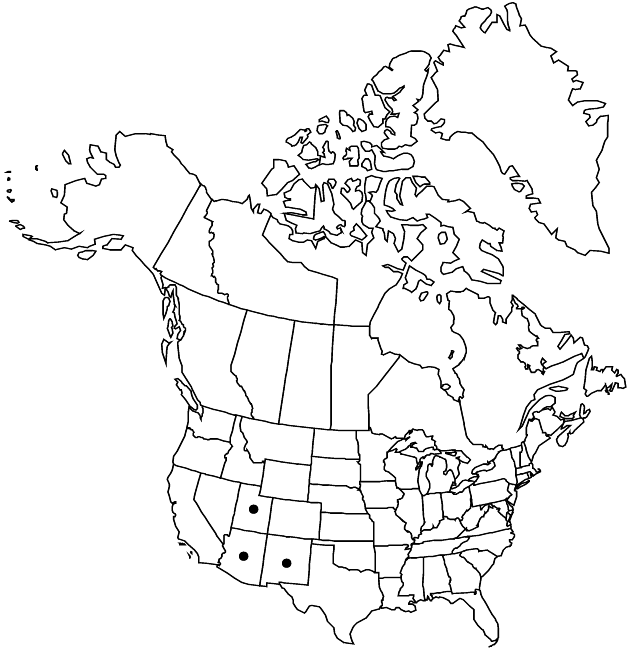Heterotheca zionensis
Brittonia 39: 384, fig. 4. 1987.
Perennials, 17–55 (–70) cm; taprooted. Stems 1–20+, ascending to erect (sometimes ± brittle, green to light-green proximally, greenish to whisith distally), moderately to densely hispid and short-strigose, abundantly long-hispid, sometimes becoming moderately hairy and densely stipitate-glandular distally. Leaves: proximal cauline petiolate to subsessile, blades (whitish when fresh, drying grayish to whitish green) narrowly to broadly oblanceolate, 15–45 × 5–8 mm, bases attenuate, margins flat, entire, strigoso-ciliate, proximally long-hispido-strigose, apices acute, faces densely hispido-strigose, sparsely to moderately stipitate-glandular; distal sessile, blades narrowly to broadly ovate or lanceolate to oblong, 10–20 (–30) × 2.5–7.3 mm, reduced distally, densely to very densely hispido-strigose, moderately to densely stipitate-glandular beneath hairs. Heads 7–27 (–46) in corymbiform arrays, branches ascending. Peduncles 9–41 mm, moderately to densely hispido-strigose, moderately to densely stipitate-glandular; bracts 0–5, proximal lanceolate, much reduced distally; linear to oblanceolate, leaflilke bracts sometimes subtending heads. Involucres cylindro-turbinate to narrowly campanulate, (4.3–) 5–7.5 (–8) mm. Phyllaries in 5–6 series, lanceolate, unequal (outer lengths 1/5–1/4 inner), margins scarious, faces either sparsely hispido-strigose and densely stipitate-glandular or moderately hispido-strigose and sparsely to moderately stipitate-glandular. Ray-florets 8–18 (–23); laminae 6.5–13 × 1–1.7 mm. Disc-florets (11–) 16–44 (–62); corollas ± ampliate, (3.5–) 4.5–7 mm, lobes 0.4–0.7 mm, sparsely pilose (hairs on lobes 0.1–0.3 mm). Cypselae monomorphic, obconic, compressed, 1.5–3 (–4) mm, ribs ca. 10, faces moderately strigose; pappi off-white, outer of linear scales 0.25–0.5 mm, inner of 25–40 weakly clavate bristles 4–7 mm. 2n = 18, 36.
Phenology: Flowering Jun–Aug(–Oct).
Habitat: Rocky, sandy, or sandy loam soils, deep sand, open places, sand dunes, sandy ledges of rock outcrops, margins of hot springs, edges of washes, cottonwood-lined washes and flood plains, grasslands, dry waste ground in juniper-pinyon scrub, roadsides
Elevation: 900–2700 m
Distribution

Ariz., N.Mex., Utah.
Discussion
Of conservation concern.
Heterotheca zionensis grows in eastern Arizona and Utah; it is introduced and established in the vicinity of Las Cruces, New Mexico; chance introductions (likely emphemeral) have been found in Moffat County, Colorado, and Franklin County, Idaho. Whitish-appearing stems and leaves readily distinguish H. zionensis from H. villosa var. scabra, which frequently occurs sympatrically in southern Utah and northern Arizona. The species could be confused also with H. villosa var. pedunculata which has more hairs/mm2 on its leaves and few or no glands on its phyllaries. It could also be confused with narrow, smaller-leaved forms of H. fulcrata var. amplifolia, which has a few petiolate-ovate bracts subtending the heads.
Selected References
None.
Lower Taxa
"[" is not declared as a valid unit of measurement for this property."]" is not declared as a valid unit of measurement for this property.